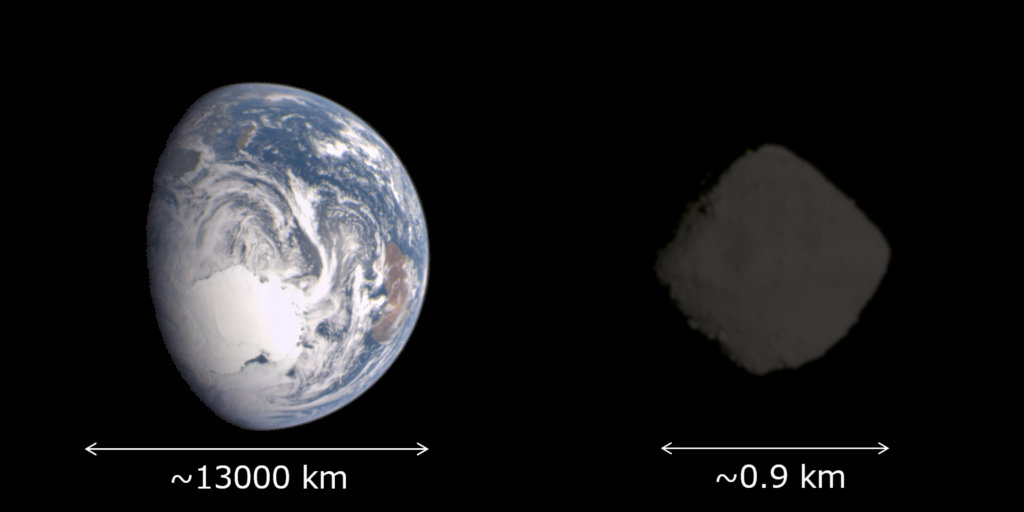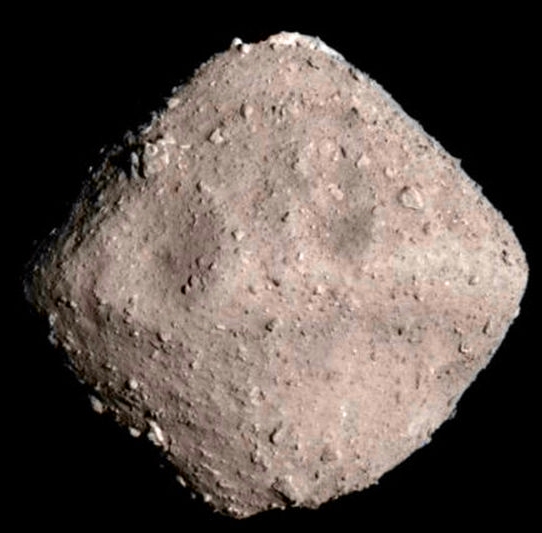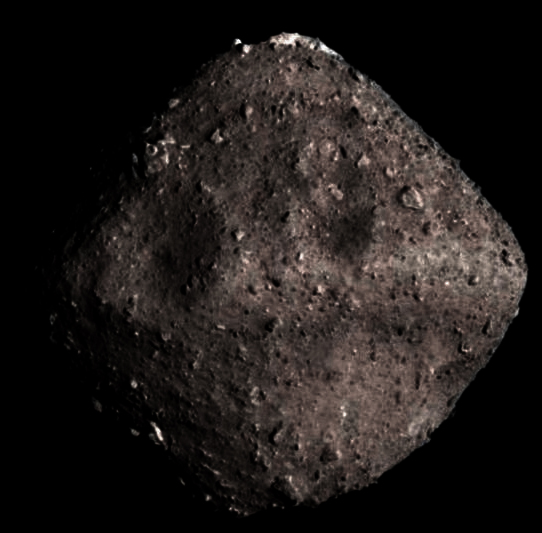It looks like you're using an Ad Blocker.
Please white-list or disable AboveTopSecret.com in your ad-blocking tool.
Thank you.
Some features of ATS will be disabled while you continue to use an ad-blocker.
share:
You have done an amazing job of adding content to this thread, thank you.
originally posted by: wildespace
First true-colour image of Ryugu (next to Earth for comparison in albedo)
Source: www.spaceflightfans.cn...
I used the colour image together with high-rez b&w image to get this:
(Saturation was slightly increased)
And with levels adjusted to reflect its low albedo. It's like a slightly reddish piece of coal.
With the looks of the surface texture and albedo it appears more like comet 67P than asteroids that have been imaged in the past. That crater looks quite different than I imagined it would from those first fuzzy pictures.
originally posted by: Devino
With the looks of the surface texture and albedo it appears more like comet 67P than asteroids that have been imaged in the past.
Most asteroids are dark like this one, due to being rich in carbon. en.wikipedia.org...
C-type (carbonaceous) asteroids are the most common variety, forming around 75% of known asteroids. [...] C-type asteroids are extremely dark, with albedos typically in the 0.03 to 0.10 range.
edit on 30-6-2018 by wildespace because: (no reason given)
New images!
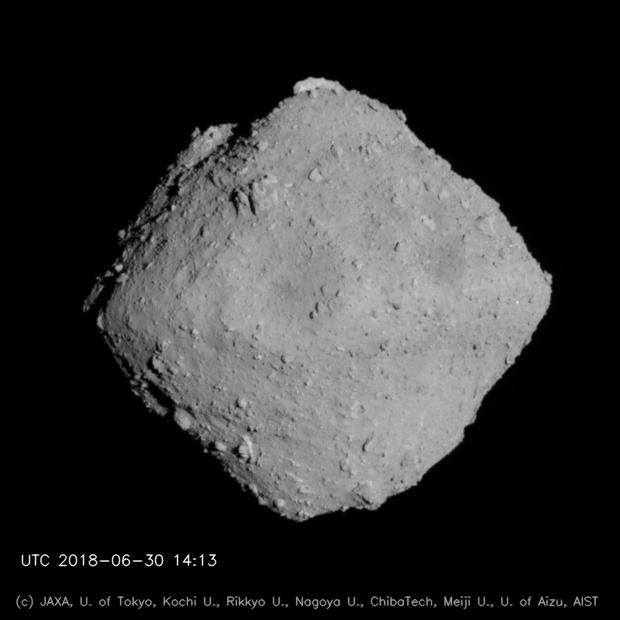

www.hayabusa2.jaxa.jp...
There's even a stereo animation for red-green glasses:
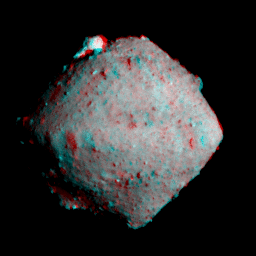
www.hayabusa2.jaxa.jp...
From the "home position" at 20 km away from asteroid Ryugu, Hayabusa2 has been confirming instrument operations in preparation for future observations. The images below show the results of part of this rehearsal observation.


www.hayabusa2.jaxa.jp...
There's even a stereo animation for red-green glasses:

www.hayabusa2.jaxa.jp...
Oh, I see what it is. It's two asteroids that have "mooshed" together at the vertical seam.
originally posted by: Blue Shift
Oh, I see what it is. It's two asteroids that have "mooshed" together at the vertical seam.
Could be, could be something else.
Surprisingly, quite a few asteroids have a similar shape:
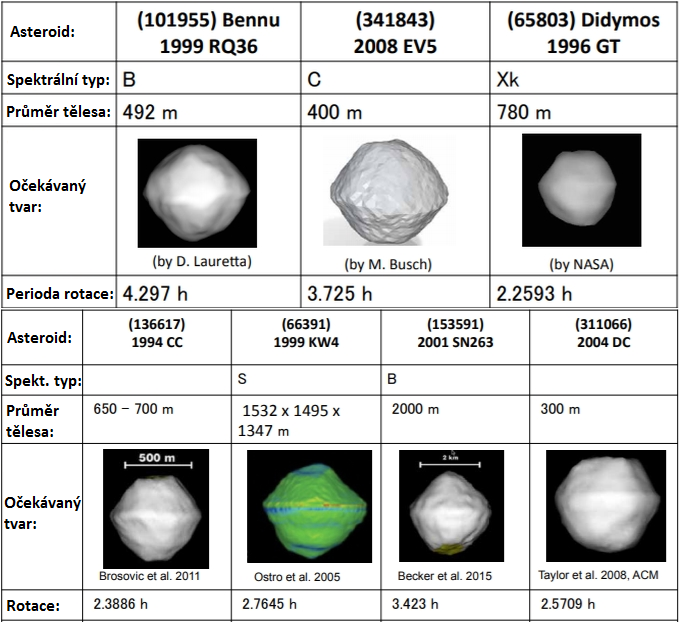
Scientists at Kobe University created this 3D model of Ryugu:
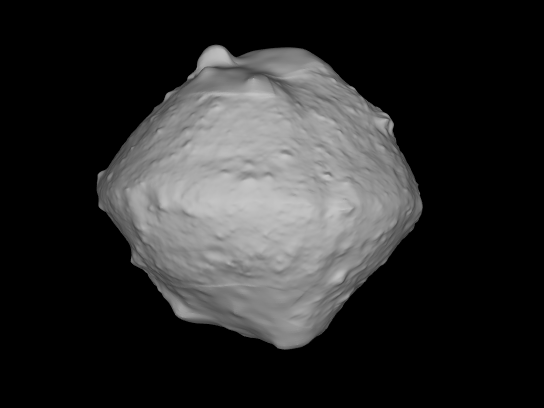
I'm now hoping that someone will stretch the textures from imagery over this model and give us some flyover videos.

I'm now hoping that someone will stretch the textures from imagery over this model and give us some flyover videos.
Cool thing about data from space missions like this one, is that members of the public can use it to create cool visualisations or animations.
Here's a rotating 3D model of Ryugu with textures from the images, simulating half-phase view: www.unmannedspaceflight.com...
(I had to compress the gif; the one in the link is better quality)

Created by Roman Tkachenko.
Here's a rotating 3D model of Ryugu with textures from the images, simulating half-phase view: www.unmannedspaceflight.com...
(I had to compress the gif; the one in the link is better quality)

Created by Roman Tkachenko.
edit on 15-7-2018 by wildespace because: (no reason given)
NEW: Hayabusa2 has descended to less than 6km from the asteroid's surface, giving us this closeup view:
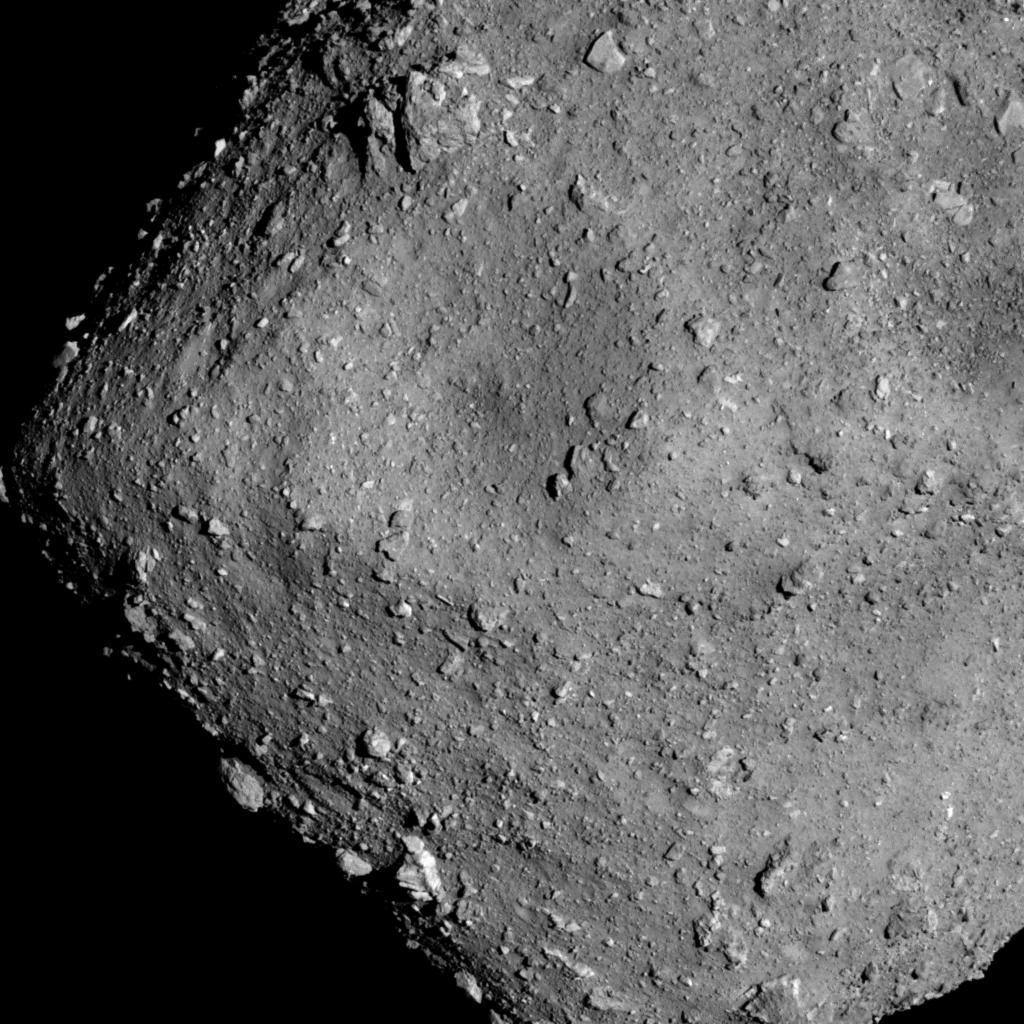
Full-scale image: www.hayabusa2.jaxa.jp...
The resolution is approx 60 cm/pixel.
www.hayabusa2.jaxa.jp...
Wow, what an image!

Full-scale image: www.hayabusa2.jaxa.jp...
The resolution is approx 60 cm/pixel.
Hayabusa2 arrived at asteroid Ryugu on June 27, after which the spacecraft remained at a distance of about 20km (the Home Position) to continue to observe the asteroid. During this time, the spacecraft was maintaining a hovering altitude of 20km above the asteroid surface. In the week of July 16, operations were begun to lower this hovering altitude, eventually bringing the spacecraft to less than 6km from the asteroid surface.
www.hayabusa2.jaxa.jp...
Wow, what an image!
edit on 25-7-2018 by wildespace because: (no reason given)
Today, one of Hayabusa2's landers has separated, and is ready to descend to the surface.
The lander, dubbed MINERVA-II1, separated when the spacecraft hovered at about 60 meters above the surface.
Here's a couple of pics taken just before separation. You can see the spacecraft's shadow cast on the asteroid:
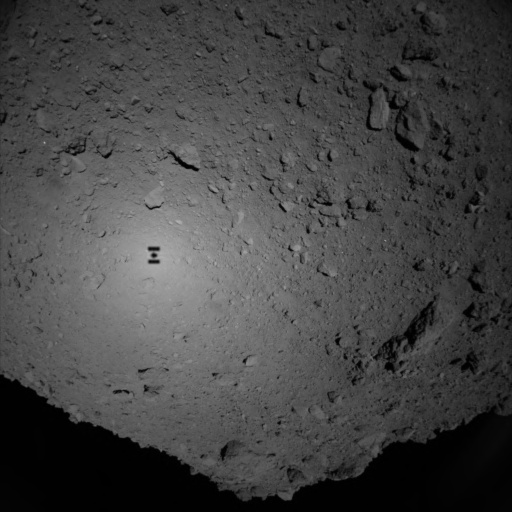
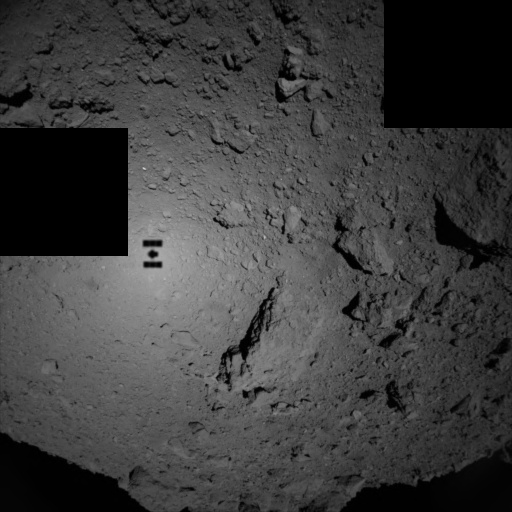
The spacecraft then started raising its altitude again.
Real-time gallery from the lander deployment stage: www.hayabusa2.jaxa.jp...
The lander, dubbed MINERVA-II1, separated when the spacecraft hovered at about 60 meters above the surface.
Here's a couple of pics taken just before separation. You can see the spacecraft's shadow cast on the asteroid:


The spacecraft then started raising its altitude again.
Real-time gallery from the lander deployment stage: www.hayabusa2.jaxa.jp...
JAXA have released this hauntingly beautiful Image from Rover-1B as it makes its way to Ryugu's surface.
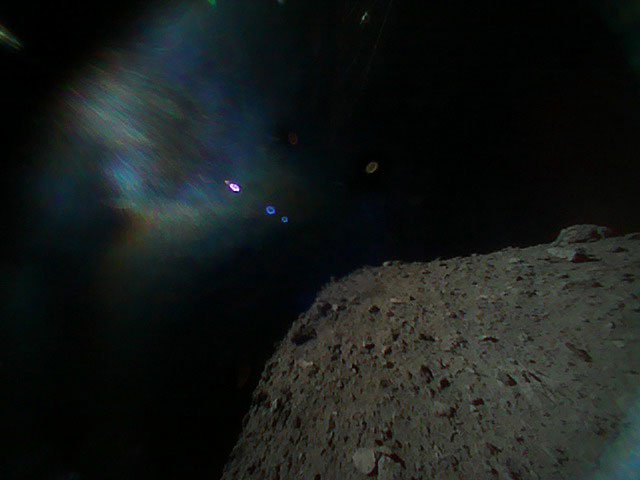
twitter.com...
How's that for a holiday snap.

twitter.com...
How's that for a holiday snap.
a reply to: wildespace
Cool...I was wondering if we can have true images
Cool...I was wondering if we can have true images
edit on 22-9-2018 by GBP/JPY because: In the FINE TEXAS TRADITION!!!!!!!!!!!!
edit on 22-9-2018 by GBP/JPY because: In the
FINE TEXAS TRADITION!!!!!!!!!!!!
Are the two craft within sight of each other? Would be great to have them photograph each other!
Another update;
They Made It! Japan's Two Hopping Rovers Successfully Land on Asteroid Ryugu

They Made It! Japan's Two Hopping Rovers Successfully Land on Asteroid Ryugu

This spectacular photo shows the view from asteroid Ryugu from the Minerva-II1A rover during a hop after it successfully landed on Sept. 21, 2018. The probe is one of two that landed on Ryugu from the Japanese Aerospace Exploration Agency's Hayabusa2 spacecraft. It's the first time two mobile rovers landed on an asteroid.
Good job Japan!!!
You guys can be very proud of a successful and fascinating scientific achievement!
Well Done!

thanks to all the posters.
You guys can be very proud of a successful and fascinating scientific achievement!
Well Done!

thanks to all the posters.
edit on 22-9-2018 by ElGoobero because: add kewl pic
Common sense tells you that their is life living in space even if its not like we imagine it.
Is this a retrieval operation as well? Will they get samples, and return them to Hayabusa2 for analysis, or better yet, will they be able to somehow
get samples back to Earth?
originally posted by: charlyv
Is this a retrieval operation as well? Will they get samples, and return them to Hayabusa2 for analysis, or better yet, will they be able to somehow get samples back to Earth?
Yes. If all goes as planned, a sample should be returned to Earth in late 2020:
Also in 2019, the mother ship will send a (nonexplosive) impactor barreling toward Ryugu. The orbiter will then cruise down to the newly created crater and collect a sample of pristine, previously subsurface material, which will come down to Earth in a special return capsule in December 2020, if all goes according to plan.
They've still got a couple more rovers to release and some other experiments to perform. It's fascinating to see a piece of robotic equipment performing complex navigation and simultaneously conducting important science research from a distance of 193 million miles away.
-dex
new topics
-
University student disciplined after saying veganism is wrong and gender fluidity is stupid
Education and Media: 15 minutes ago -
Geddy Lee in Conversation with Alex Lifeson - My Effin’ Life
People: 1 hours ago -
God lived as a Devil Dog.
Short Stories: 1 hours ago -
Happy St George's day you bigots!
Breaking Alternative News: 3 hours ago -
TLDR post about ATS and why I love it and hope we all stay together somewhere
General Chit Chat: 4 hours ago -
Hate makes for strange bedfellows
US Political Madness: 6 hours ago -
Who guards the guards
US Political Madness: 8 hours ago -
Has Tesla manipulated data logs to cover up auto pilot crash?
Automotive Discussion: 10 hours ago
top topics
-
Hate makes for strange bedfellows
US Political Madness: 6 hours ago, 14 flags -
whistleblower Captain Bill Uhouse on the Kingman UFO recovery
Aliens and UFOs: 15 hours ago, 11 flags -
Who guards the guards
US Political Madness: 8 hours ago, 10 flags -
1980s Arcade
General Chit Chat: 17 hours ago, 7 flags -
TLDR post about ATS and why I love it and hope we all stay together somewhere
General Chit Chat: 4 hours ago, 4 flags -
Happy St George's day you bigots!
Breaking Alternative News: 3 hours ago, 3 flags -
Has Tesla manipulated data logs to cover up auto pilot crash?
Automotive Discussion: 10 hours ago, 2 flags -
God lived as a Devil Dog.
Short Stories: 1 hours ago, 2 flags -
Geddy Lee in Conversation with Alex Lifeson - My Effin’ Life
People: 1 hours ago, 2 flags -
University student disciplined after saying veganism is wrong and gender fluidity is stupid
Education and Media: 15 minutes ago, 2 flags
active topics
-
Tucker Carlson UFOs are piloted by spiritual entities with bases under the ocean and the ground
Aliens and UFOs • 41 • : FlyersFan -
Happy St George's day you bigots!
Breaking Alternative News • 29 • : Freeborn -
University student disciplined after saying veganism is wrong and gender fluidity is stupid
Education and Media • 1 • : watchitburn -
Thousands Of Young Ukrainian Men Trying To Flee The Country To Avoid Conscription And The War
Other Current Events • 116 • : Consvoli -
"We're All Hamas" Heard at Columbia University Protests
Social Issues and Civil Unrest • 247 • : FlyersFan -
Silent Moments --In Memory of Beloved Member TDDA
Short Stories • 68 • : Encia22 -
British TV Presenter Refuses To Use Guest's Preferred Pronouns
Education and Media • 118 • : Consvoli -
-@TH3WH17ERABB17- -Q- ---TIME TO SHOW THE WORLD--- -Part- --44--
Dissecting Disinformation • 625 • : daskakik -
OUT OF THE BLUE Chilling moment pulsating blue cigar-shaped UFO is filmed hovering over PHX AZ
Aliens and UFOs • 46 • : burritocat -
Geddy Lee in Conversation with Alex Lifeson - My Effin’ Life
People • 2 • : DAVID64

